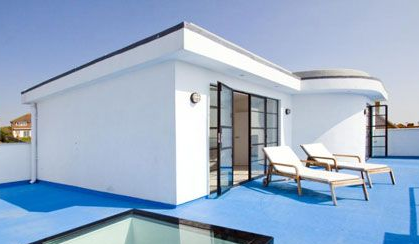The built environment has the potential to be a powerful force for good in the ongoing battle against human pandemics. In fact, it has a track record. Kathryn Lennon-Johnson FRSA looks at the powerful architectural designs of the Art Deco period in the fight against tuberculosis and asks whether the construction industry is ready to shape our roaring twenties with modern solutions to our current woes.
The built environment matters. It has consequences. The things we build impact generations to come. According to the US Environmental Protection Agency, we spend 90% of our time indoors. Right now we are experiencing the limitations of some of those indoor spaces; light, acoustics, thermals and air quality. And there are limitations outside, too; space designated to cars means that pavements and public spaces are too narrow for successful social distancing.
You are not imagining the significance of your environment right now; it really could be contributing to the way you feel. There have been suggestions that our mental wellbeing after Covid-19 will replicate a form of post-traumatic stress disorder and mental health also has physical repercussions. High-density developments, residential crowding and loud external noise can cause psychological stress, which raises cortisol levels and weakens the cardiovascular system. Insufficient daylight is associated with depressive symptoms. Even a simple view of greenery can make a difference to our primitive brain. Famous 1980s research by Roger Ulrich monitored hospital patients who had leafy views and found that patients with a window looking onto nature had fewer surgical complications, healed faster, and required less pain medication.
The built environment has previously provided solutions to contagious problems. This integration of form with social purpose is most recognisable in buildings from the early-1900s, designed to tackle tuberculosis with clean, circulating air. The distinctive features of Art Deco such as flat roofs, balconies and garden terraces intended to limit the spread of germs while providing key ingredients for recovery: dry, fresh air and sunshine.
Pretty buildings probably aren’t the answer.
How did we get to the point that the built environment does us harm? Construction as an industry has not historically been at the cutting edge of innovation or responsibility. Traditionally, construction is reluctant to embrace change and apathetic about the consequences of the things we build with the focus squarely on lowest cost with least risk. In fact, the UK has some of the smallest homes in Europe, according to research by property company Sellhousefast.uk, which found the average three-bedroom home measures just 88m2, 5m2 smaller than the regulatory minimum.
In the UK, the Department for Environment Food and Rural Affairs (Defra) cites that 80% of buildings that will be occupied in 2050 have already been built, but that doesn’t mean we can’t build the future that we need. New mindsets, new attitudes, new skills and new technologies could help us create the new normal. By championing and amplifying these skills, we give them space to create new solutions and identify existing possibilities. Amongst the contenders could be enzymatic paint and plaster that kill 100% of bacteria and viruses on contact, antiviral UV light, antimicrobial door furniture, heating, ventilation and air-conditioning systems that create a temperature zone to render viruses unviable, and air filters that remove pathogens. Traditional materials like copper and copper alloys are naturally antimicrobial with intrinsic properties to destroy a wide range of microorganisms. While each of these products has problems, including short service lives and material scarcity, they might form the beginning of conversations.
We need to remember that nature will not challenge us exactly the same way again. Though architecture is still a discipline of invention and imagination, construction is not the visionary industry of 100 years ago, and financially clients will be working with reduced budgets for a while. Drifting ‘back to normal’ should not be the default. Normal wasn’t good enough. Let us go forward to better, and we can start with the knowledge and skills of construction apprentices and students. Many construction apprentices are facing uncertain futures as they are furloughed but we must not go backwards on all our hard work and hard-won achievements. It takes a village to raise an apprentice, and as taxpayers, we should all be vocal in our rejection of the things that fail to build the future we need.
Active citizenship.
Where can we focus our attention and voice to create this 21st-century answer to Art Deco healthful living?
1) Push for innovation and technology
Whilst we will not suddenly be replacing existing housing stock (supply is already significantly less than demand) we can push for retrofit, repair, thought, innovation and technology. Although it is unlikely that we can all be surrounded by the forests of the sanatoria that inspired Deco architecture, green walls and green roofs are tried-and-tested features that improve air quality and reduce psychological stressors.
2) Embrace profitable opportunities
Humans excel at learning from disaster and necessity, and the power of capitalism-on-purpose is ours to tap. Money follows the channels we create for it and there are significant profits to be made by embracing the opportunities.
3) Fight to make things better
Putting responsibility in the hands of old mindsets means progress risks being forgotten under the guise of ‘safe ideas’. We need to stay dissatisfied and stay focused on all the things that need to be better. The danger of looking the other way means we might not go back to an average past; it could roll back decades of progress. We have an opportunity to spur the recovery and create what we want by mobilising people and holding the line for what we will accept.
4) Continue to share ideas and solutions
Connection and communication have been key to surviving lockdown, and we can continue to share ideas, solutions, innovations, experiments, guidance and data. What built environment features do we know to be valuable that we can prioritise in our conversations? Collaboration and open-sourcing also mean we can support the construction students and apprentices who may yet become the built environment saviours we all need.
Originally written for RSA Comment: https://www.thersa.org/discover/publications-and-articles/rsa-comment/2020/04/the-viral-incentive-to-build-better-stuff

